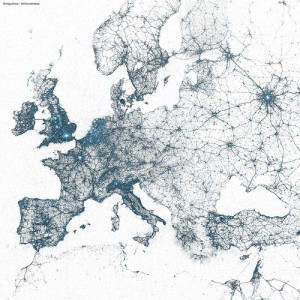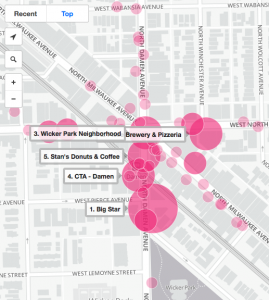Gordon & Souza e Silva define ‘Net Locality’, 2011, in terms of, “a ubiquity of networked information”, (p2), by investigating behaviour that is dependent on, or created by, locational data, which is discoverable by mobile technologies. Their intention is to see “what happens to individuals and societies when virtually everything is located or locatable”, (ibid). However, the marketing industry currently refer to these technologies as ‘SoLoMo’ (Social, Local, Mobile), where the focus is primarily on the possibilities for commodification of location-based services.
In an attempt to better understand how it is to be visible and locatable through mobile technology, I signed up to the mobile, location-based app. Foursquare with the intention of experiencing and interacting with the app. within my everyday routine and local area. The territory covered generally fell within what Humphreys and Liao refer to as the “parochial realm”, public yet familiar and contextual, “along routes and patterns of our everyday lives”. However, Foursquare does not appear to be well used in my locale and I did not experience “social exchanges through the network” in the small time with the app so far, meaning I have not had significant opportunity to see how parochialisation is affected by location based technology. Through further and continued use there might be opportunity to feel part of a Foursquare community, seeing as this was not really possible over the few days I used it.
I found myself surprised at how place is organised within the app. for example, my parish church, which was built around 1080 AD, and I consider to be a significant local landmark was not featured on Foursquare, giving me opportunity to create an entry. I contrast, the café in my local park had three slightly different entries and the local zoo had an main page, along with a number of separate entries for zones containing different activities, such as the play park and one of the food outlets, even though none of these are separate franchises.
Gordon and Souza e Silva (2011) discuss specific location based mobile games generally as specific events, however since their book was published many non-game apps have become gamified, i.e. utilising game elements and mechanics to a non- game situation. Foursquare has gamified elements added, as I gained points, a couple of badges and became ‘Mayor’ of my workplace (with just two check-ins). With further use I can imagine these game elements “potentially create user motivation to engage” (Gordon & Souza e Silva, 2011 p65.), creating an incentive to return regularly to the app.
In thinking about location based technologies this week, I also wanted to draw your attention to a few interesting links and examples:
Twitter has a Flickr page with visualisations of billions geo-tagged Tweets organised onto corresponding maps (Every dot is a Tweet, and the color is the Tweet count.)
Herefeed.com uses information gathered from Instagram for you to select and area and then view where people are taking the most pictures. They call this a ‘heat map’, under this images are displayed, grouped by specific locations (bars, shops, scenic places etc) Although, location does not define content as many of the images are not of the places they were uploaded from.
Filip, is a “wearable smart locator and phone for kids”, its a watch and a pre-programmable phone (can store 5 numbers and only these numbers can call the phone), with location-based technology, so you can find where the child/device is. 
References
Humphreys L & Liao T (2013) Foursquare and the parochialization of public space. First Monday Vol. 18, No, 11
Gordon E & Souza e Silva A (2011) Net Locality. Wiley Blackwell, UK
Reed R. (2011) The SoLoMo Manifesto http://momentfeed.com/whitepaper/ accessed 10/03/14


